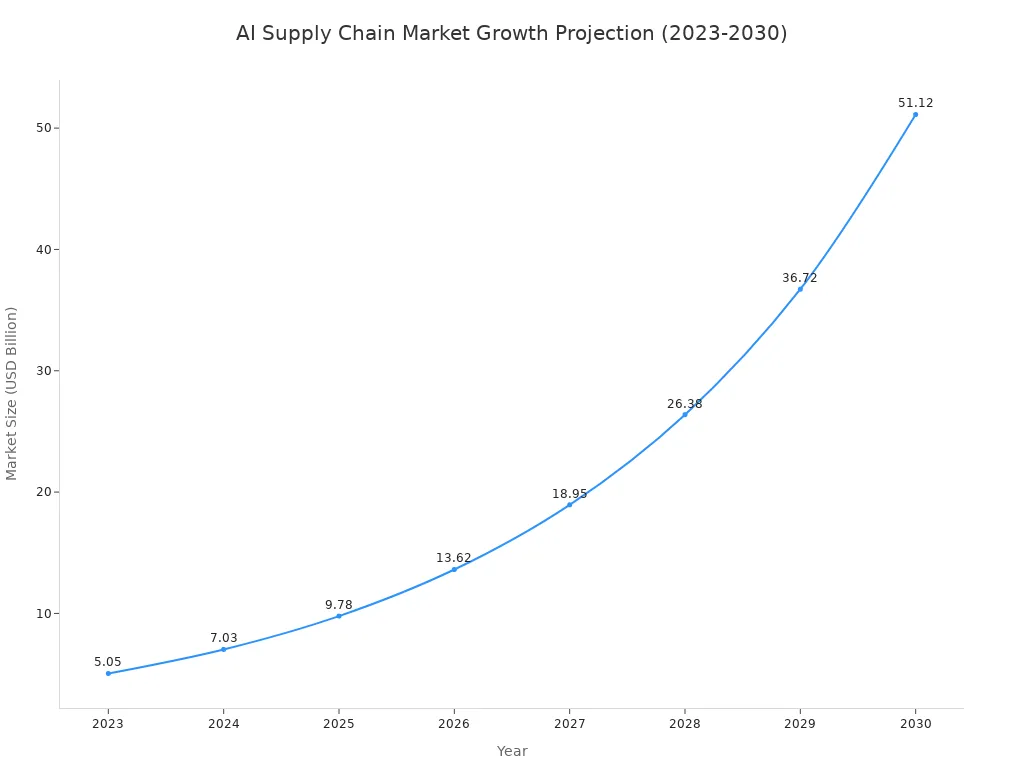
Yes, some advanced AI tools are reading social media, and this capability is transforming your inventory management and social media strategy. These AI social media tools use predictive analytics on viral content and influencer content for market trend analysis, providing crucial audience insights from user-generated content. Your marketing can leverage sentiment analysis for better audience engagement. This data-driven decision making improves personalization and content creation, boosting engagement. Effective social media management and social media marketing, powered by real-time data and ai-driven insights, enhance your engagement with content. This ai-driven demand forecasting strategy can reduce stockouts by 30%. The market for ai-powered inventory forecasting is booming, showcasing the value of this social media tools approach. The right content drives engagement and sales. This content is key to your marketing. This content is vital. This content matters. This content is your future. This content defines your brand.
Market Growth Projection: AI in Inventory Management 📈 The demand for this technology is accelerating, reflecting its critical role in a competitive landscape.
Metric Value Forecast Period 2025 - 2029 Compound Annual Growth Rate (CAGR) 29.8% Forecasted Market Value by 2029 $27.23 Billion
From social chatter to inventory action

You can transform social media chatter into direct inventory action. Your advanced AI tools do not just listen; they interpret and act. This process turns raw social media content into a powerful strategy for your inventory management. The right AI social media tools connect online engagement to your warehouse, creating a seamless flow from market trend analysis to automated decision-making. This marketing strategy gives you a significant competitive edge.
Identifying key social signals
Your AI tools identify key signals using Natural Language Processing (NLP). They use sentiment analysis to process social media text. This converts customer opinions from social media content into actionable insights for your marketing. These insights improve your predictive analytics models for product demand. The AI social media tools differentiate between general discussion and real purchase intent.
Pro Tip: Your AI models learn from past data patterns. This training improves their ability to distinguish serious buyers from casual browsers, refining your audience insights and content creation for better audience engagement.
The signals also vary by product type. Your social media marketing strategy must recognize these differences in content and engagement.
| Product Type | Key Social Signals & Focus |
|---|---|
| B2B Products | Focus on professional discussions and value-driven engagement on platforms like LinkedIn. |
| B2C Products | Track likes, shares, and comments on visual content to understand preferences and build loyalty. |
The role of real-time data integration
Waiting for data is no longer a viable strategy. Batch processing, where data is updated every few hours, causes delays and missed opportunities. Real-time data integration is essential for effective AI operations. It provides instant access to critical data. This enables agile and responsive decision-making for your social media management. Your business gains enhanced customer experiences through this timely personalization. This approach optimizes your operational efficiency and improves data accuracy, giving you reliable content for confident decisions. This is the foundation of modern ai-driven demand forecasting and your overall marketing strategy.
Connecting insights to your ERP
The final step connects social insights to your Enterprise Resource Planning (ERP) system. This connection requires APIs to allow your social media tools and inventory management software to communicate. Your AI tools use secure authentication and manage data formats like JSON to translate social media engagement into inventory commands. This integration powers ai-powered inventory forecasting. It allows your system to automatically adjust stock levels based on social media trends. This connection between your social media strategy and inventory management is what makes your predictive analytics truly powerful. The AI social media tools drive this entire process, turning content engagement into smart business actions.
Social signals and inventory impact

You can directly connect social media signals to your inventory levels. This is where your AI tools move beyond simple listening and into proactive management. Your strategy transforms online conversations into tangible actions that protect your revenue and enhance your brand reputation. These concrete scenarios show how your AI social media tools turn market chatter into a decisive competitive advantage for your marketing efforts.
Using predictive analytics for viral demand
Imagine a beauty influencer posts a TikTok video featuring your new lip gloss. The content goes viral overnight. Your traditional quarterly forecasts would completely miss this surge. Your advanced AI tools, however, are built for this moment. They immediately detect the anomaly.
The AI uses predictive analytics to evaluate the trend's potential. It analyzes thousands of data points in real time to understand the magnitude of the demand spike. Key metrics your AI tools track include:
- Engagement Velocity: The system monitors the rapid growth of likes, shares, and comments.
- Comment Sentiment: Sentiment analysis confirms the comments are overwhelmingly positive and show strong purchase intent.
- Follower Growth: The AI flags unusual follower surges for the influencer and your brand's social accounts.
- Cross-Platform Activity: It checks if the trend is spilling over from TikTok to Instagram Reels or YouTube Shorts.
- Content Characteristics: The AI studies the video's audio, visual style, and hashtags to see if it matches patterns of past viral content.
From Insight to Action ⚡ Before your team even sees the morning sales report, the system flags the viral event. It generates an alert recommending an immediate increase in production and a reallocation of stock to your direct-to-consumer warehouse. This automated decision-making helps you meet the surge in demand, preventing a stockout and capturing maximum revenue.
Your AI social media tools also use predictive analytics to model the trend's entire lifecycle. They forecast how quickly the trend will grow and, just as importantly, when it will fade. This prevents you from overstocking a product after the viral moment passes, protecting your business from excess inventory and markdowns. This is a core part of a modern inventory management strategy.
Responding to negative feedback
Now, consider a different scenario. You launch a new smart home device, but a software bug is causing connectivity issues. A few negative comments appear on Twitter. Soon, a Reddit thread gains traction, and a tech YouTuber posts a critical review. The negative content is spreading.
Your AI tools are designed to distinguish isolated complaints from a full-blown crisis. The system identifies a widespread issue by monitoring several factors:
- Volume and Velocity: It detects a sudden, rapid increase in negative mentions across multiple platforms.
- Contextual Understanding: Using sentiment analysis, the AI understands that terms like "doesn't connect," "frustrating," and "returning this" signal a serious product flaw, not just minor dissatisfaction.
- Cross-Platform Correlation: The AI connects the dots between the negative engagement on Twitter, the detailed complaints on Reddit, and the critical video review on YouTube, confirming a widespread problem.
Based on this analysis, your system triggers an alert. It signals a probable drop in demand and advises you to pause or reduce future purchase orders for the device. This swift action, driven by your social media tools, prevents you from ordering more faulty inventory. It gives your marketing and product teams critical time to address the issue, manage public relations, and protect your brand. This proactive inventory management strategy turns a potential disaster into a manageable problem.
Capitalizing on regional trends
Your customers' preferences are not the same everywhere. A lightweight jacket might be trending in Southern California, while a fleece-lined version of the same content is gaining engagement in the Northeast. Your AI marketing tools can capture these regional nuances to optimize your inventory.
For example, a company like H&M uses its AI system to analyze localized data. The AI social media tools review regional social media trends, local events, and even weather patterns. This allows for highly specific ai-powered inventory forecasting. Your social media marketing can use this data for better personalization.
This strategy allows you to:
- Allocate Stock Geographically: Ship more of the fleece-lined jackets to your Boston stores and more lightweight versions to your Los Angeles locations.
- Inform Local Marketing: Your regional marketing teams can use these insights for targeted content creation and promotions that resonate with local audience engagement.
- Reduce Waste: You minimize the risk of products sitting unsold in the wrong climate, leading to fewer markdowns and higher profit margins.
By connecting your ai-driven demand forecasting to regional social signals, you ensure the right content and products are in the right place at the right time. This sophisticated social media strategy improves the customer experience and makes your entire supply chain smarter and more responsive.
Evaluating your current AI tools
You need to know if your current systems are up to the task. Evaluating your AI tools helps you understand their true capabilities. This review ensures your technology investment supports your marketing and inventory management strategy. A proper evaluation reveals if your social media tools provide the deep insights needed for modern commerce.
Look for social listening features
Your AI tools must go beyond simple keyword tracking. You need advanced social listening to understand the context behind the content. Basic tools count mentions, but advanced AI social media tools interpret meaning. They use sophisticated sentiment analysis to gauge customer feelings accurately. This helps your social media marketing team improve audience engagement. The right content creation depends on this deep understanding.
Basic vs. Advanced AI Listening Your marketing strategy needs AI that understands nuance. See how advanced social media tools provide superior engagement insights.
Feature Basic Keyword Tracking Advanced AI Social Listening Analysis Counts keyword frequency Understands context, sarcasm, and emotion Content Tracks text only Analyzes text, images, and video content Insights Requires manual interpretation Provides actionable recommendations
Review data source connections
You must review how your AI tools access data. Social media platforms control data access through APIs, and not all connections are equal. Some platforms limit data, which impacts the quality of the content your social media tools receive. For example, free or low-cost API tiers often restrict real-time data and historical content. Your vendor's access level determines the quality of insights you get for your marketing. This directly affects the reliability of your engagement data and personalization efforts.
Ask your vendor the right questions
You should ask your vendor specific questions to confirm their capabilities. These questions help you validate their claims and protect your business. Your AI social media tools are a major part of your marketing strategy. Make sure they deliver real value.
Start with these essential questions:
- Accuracy and ROI: What forecast accuracy can we expect after six months? AI tools can reduce forecasting errors by 20-50%. Ask for case studies that prove their system's impact on inventory costs and sales.
- Data and Training: What data was used to train your AI models? How do you ensure the content used for training is unbiased and properly licensed? This protects you from using a system built on flawed or illegally sourced content.
- Security and Privacy: How do you protect our data? Does our information ever leave your secure environment to train public models? You need to ensure your vendor follows security frameworks like ISO 27001 or SOC 2 to safeguard your engagement data. This is crucial for your ai-powered inventory forecasting and overall inventory management.
AI using social signals is a present-day reality for proactive inventory management. Your competitors are adopting this marketing strategy. They analyze social content for better engagement. Their marketing success depends on this content. This content drives their engagement. Your marketing needs this content. This content is vital for engagement. This content is your future. This content defines your brand. This content is your engagement. The market is projected to reach $51.12 billion by 2030.

You must evaluate your current strategy. Investigate your tools or upgrade your system. A smarter supply chain depends on this action.
FAQ
How does AI analyze social media content?
Your AI tools use Natural Language Processing (NLP) to understand text. They also use computer vision to interpret image and video content. This technology identifies trends, sentiment, and purchase intent from a massive volume of public content.
Is using social media content for inventory legal?
Yes, AI analyzes publicly available content. Your system must comply with data privacy regulations like GDPR. It does not access private user content. The focus is on aggregated trends from public posts, not individual surveillance. This content is a public signal.
Compliance Tip 📝 You should always verify your AI vendor's data sourcing policies. Ensure they only process public content and adhere to platform terms of service. This protects your business.
What kind of content provides the best insights?
User-generated content provides the best insights. This includes video reviews, unboxing posts, and authentic customer photos. This type of content shows genuine purchase intent. The best content is unfiltered and direct from your audience. This content is invaluable.
Can small businesses use this technology?
Yes, many AI vendors offer scalable solutions for small businesses. You can find tools that fit your budget. These systems help you analyze social content effectively. They provide powerful insights without requiring a large data science team.
See Also
Sustainable Fashion: AI Innovations for a Greener Global Future
AI-Driven Production Forecasting: Boosting Accuracy for 2024 Enterprise Success
Machine Learning: Predicting Fashion Trends to Significantly Boost Retail Sales
Top 10 E-commerce Platforms Streamlining Accounting Integration for Businesses
Optimizing Retail Inventory: Predictive Analytics for 2025 Re-stocking Strategies